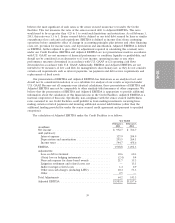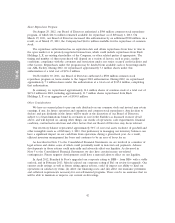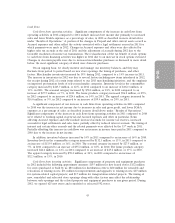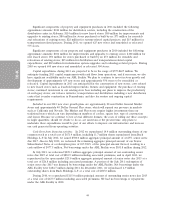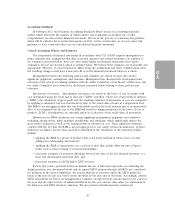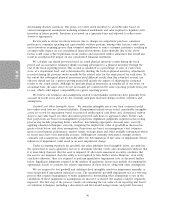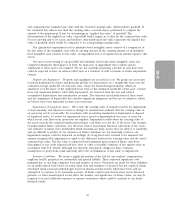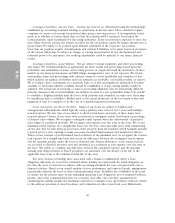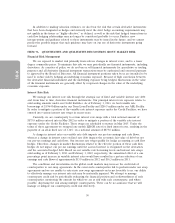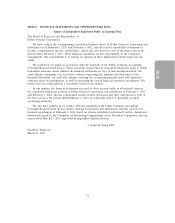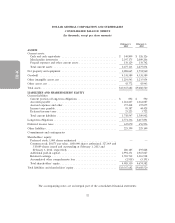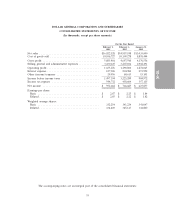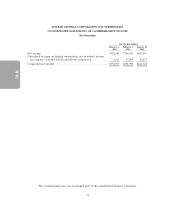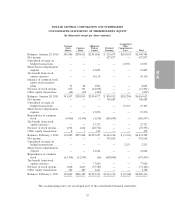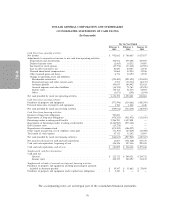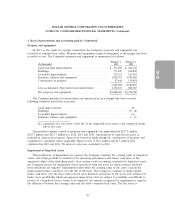Dollar General 2012 Annual Report Download - page 128
Download and view the complete annual report
Please find page 128 of the 2012 Dollar General annual report below. You can navigate through the pages in the report by either clicking on the pages listed below, or by using the keyword search tool below to find specific information within the annual report.
10-K
these estimates have not been materially inaccurate; however, if actual timing and potential termination
costs or realization of sublease income differ from our estimates, the resulting liabilities could vary
from recorded amounts. These liabilities are reviewed periodically and adjusted when necessary.
Share-Based Payments. Our share-based stock option awards are valued on an individual grant
basis using the Black-Scholes-Merton closed form option pricing model. We believe that this model
fairly estimates the value of our share-based awards. The application of this valuation model involves
assumptions that are judgmental and highly sensitive in the valuation of stock options, which affects
compensation expense related to these options. These assumptions include the term that the options
are expected to be outstanding, the historical volatility of our stock price, applicable interest rates and
the dividend yield of our stock. Other factors involving judgments that affect the expensing of share-
based payments include estimated forfeiture rates of share-based awards. Historically, these estimates
have not been materially inaccurate; however, if our estimates differ materially from actual experience,
we may be required to record additional expense or reductions of expense, which could be material to
our future financial results.
Fair Value Measurements. We measure fair value of assets and liabilities in accordance with
applicable accounting standards, which require that fair values be determined based on the assumptions
that market participants would use in pricing the asset or liability. These standards establish a fair value
hierarchy that distinguishes between market participant assumptions based on market data obtained
from sources independent of the reporting entity (observable inputs that are classified within Levels 1
and 2 of the hierarchy) and the reporting entity’s own assumptions about market participant
assumptions (unobservable inputs classified within Level 3 of the hierarchy). Therefore, Level 3 inputs
are typically based on an entity’s own assumptions, as there is little, if any, related market activity, and
thus require the use of significant judgment and estimates. Currently, we have no assets or liabilities
that are valued based solely on Level 3 inputs.
Our fair value measurements are primarily associated with our derivative financial instruments,
intangible assets, debt instruments, and to a lesser degree our investments. The values of our derivative
financial instruments are determined using widely accepted valuation techniques, including discounted
cash flow analysis on the expected cash flows of each derivative. This analysis reflects the contractual
terms of the derivatives, including the period to maturity, and uses observable market-based inputs,
including interest rate curves. The fair values of interest rate swaps are determined using the market
standard methodology of netting the discounted future fixed cash payments (or receipts) and the
discounted expected variable cash receipts (or payments). The variable cash receipts (or payments) are
based on an expectation of future interest rates (forward curves) derived from observable market
interest rate curves. The application of valuation models involves assumptions such as discounted cash
flow analysis and interest rate curves that are judgmental and highly sensitive in the fair value
computations. In recent years, these methodologies have produced materially accurate valuations.
Derivative Financial Instruments. We account for our derivative instruments in accordance with
accounting standards for derivative instruments (including certain derivative instruments embedded in
other contracts) and hedging activities, as amended and interpreted, which establish accounting and
reporting requirements for such instruments and activities. These standards require that every
derivative instrument be recorded in the balance sheet as either an asset or liability measured at its fair
value, and that changes in the derivative’s fair value be recognized currently in earnings unless specific
hedge accounting criteria are met. See ‘‘Fair Value Measurements’’ above for a discussion of derivative
valuations. Special accounting for qualifying hedges allows a derivative’s gains and losses to either offset
related results on the hedged item in the statement of operations or be accumulated in other
comprehensive income, and requires that a company formally document, designate, and assess the
effectiveness of transactions that receive hedge accounting. We use derivative instruments to manage
our exposure to changing interest rates, primarily with interest rate swaps.
49


